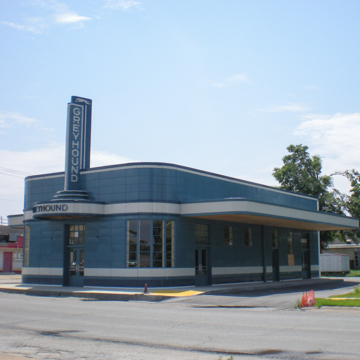This bus station is the only remaining Art Moderne Greyhound bus terminal in Arkansas, which in itself makes it exceptional, but it is also noteworthy for its colorful and eye-catching exterior in this small-town setting. The exterior facade of blue Vitrolux structural glass panels and ivory detailing remains intact. The building’s narrow front is curved at corners of the facade with wraparound windows, and the curves are repeated in the shape of the canopies sheltering the entrance and the side walls. Greyhound’s distinctive vertical sign with the company’s name written in white letters on a blue background rises above the entrance canopy and at its top is the image of a racing greyhound, the company’s logo. The logo and the building’s curved forms all convey an appropriate impression of movement and speed. Until 1963, the station’s original plan reflected the racial segregation of its time, with a central ticket office and an adjacent kitchen area separating two sets of facilities (waiting rooms, bathrooms, and lunch counters). The facilities for blacks were smaller than those for whites and were unadorned. After federal desegregation the spaces for the black patrons were converted for storage and freight. Blytheville is the county seat, and its location on a major north–south route and proximity to the Mississippi River made it a busy cotton-shipping port. The bus station closed in the late 1990s and was restored by Hord Architects of Memphis for use as a visitor center.
You are here
Historic Blytheville Greyhound Bus Station
If SAH Archipedia has been useful to you, please consider supporting it.
SAH Archipedia tells the story of the United States through its buildings, landscapes, and cities. This freely available resource empowers the public with authoritative knowledge that deepens their understanding and appreciation of the built environment. But the Society of Architectural Historians, which created SAH Archipedia with University of Virginia Press, needs your support to maintain the high-caliber research, writing, photography, cartography, editing, design, and programming that make SAH Archipedia a trusted online resource available to all who value the history of place, heritage tourism, and learning.






